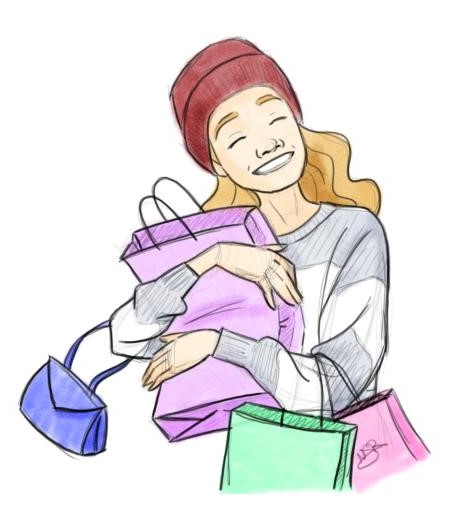
Tiktok, the social media platform, has taken the world over by storm, with an algorithm that’s perfectly curated to every user’s needs, wants, and interests. For me, it contains a plethora of Amsterdam hotspots I “must visit”, hauls from stores I must “run, not walk to”, and tools and gadgets that are an “absolute essential”. Regardless of everyone’s unique interests, however, there seems to be an umbrella concept enveloping all of TikTok — pushing the agenda that more is better.
Tiktok, the social media platform, has taken the world over by storm, with an algorithm that’s perfectly curated to every user’s needs, wants, and interests. For me, it contains a plethora of Amsterdam hotspots I “must visit”, hauls from stores I must “run, not walk to”, and tools and gadgets that are an “absolute essential”. Regardless of everyone’s unique interests, however, there seems to be an umbrella concept enveloping all of TikTok — pushing the agenda that more is better.

Illustration by Nina Kollof

Illustration by Nina Kollof
Consumerism, the cultural phenomenon of the notion that self-worth, happiness, and social status are derived from one’s material possession (Ozgen, 2019), is not a new concept, and can be dated back to ancient civilizations (Walsh, 2019). Acquisition of goods has a certain allure to it, a comfort that can only come about, at first glance, from ownership. Social media, however, has allowed for the limits of this materialism to be pushed to an all-time high. The products that are ‘consumed’ in this scenario do not only refer to its primary connotation of tangible objects — it extends into ownership linked to a lifestyle, or an image that the item brings about. Tiktok, alongside a variety of social media platforms, has allowed for a nurturing of fast-paced, perpetually unattainable images. These are unattainable in that the moment you feel like you caught up, it slips right through your fingers as a new desirable item, a new hurdle, is placed in front of you.
Before we get into over-fixation of material goods and why this brings comfort, we need to understand basic spending and the processes behind it. By referencing Maslow’s Hierarchy of Needs, it can be reasonably inferred that the basic drives for spending are physiological and safety needs (Wells, 2022). Once the bottom tier needs are fulfilled, the person can move on to seeking satisfaction on the higher levels, such as love and belonging and esteem. Here, a communal aspect seems to come into play – the desire to fulfill a role for prestige or recognition is a particularly strong social factor (Leonardelli et al., 2010). This becomes particularly complicated due to the ever-changing reference group that people choose to compare themselves to on social media (Social Factors Affecting Consumer Behaviour, n.d.) By presenting streams of comparisons on social media, the urge to spend to feel closer to a favorable reference group is maximized, specifically because social media trends make these desirable reference groups to change at lightning speed. Spending outside of immediate necessity is entirely justified – the issue may come about when these needs are manipulated, exacerbating spending habits and retail therapy craze in the ever-digitized world.
This behavior that is rooted in satisfaction of social goals can also extend into learned associations between comfort/satisfaction and acquiring products. Once the link has been established, social media can very easily nurture the habit of buying and acquisition through consistent streaming of content, be it using media marketing strategies or through the sharing of a certain lifestyle/acquired product online.
“Put simply, non-materialism, not assigning worth or happiness to possessions, is most related to happiness, but if you have the means to be materialistic, you can get away with it.”
Despite acquisition and ownership being linked to increased group belonging, another line of research shows that material pursuits that take time away from relations with your immediate circle of friends and family can actually have a negative effect on well-being and happiness (DeAngelis, 2004). What these lines of reasoning suggest in combination is that, as social media increases the number of comparison groups a person references, there is a proportional increase of pursual of products and services to enhance feelings of belonging and comfort. This, however, may in the long-run detach a person from investing into their immediate surroundings.
Does the contentment of this constant acquisition actually last? Of course, people differ in their initial attitudes to paying and spending due to a multitude of social and/or cognitive factors. An MRI study has shown that people can have different patterns of brain activation at the thought of paying, before the spending has taken place (Rick, 2021). Dr. Scott Rick, the researcher behind this study, has later gone on to develop the “tightwad/spendthrift scale”, defining people based on their attitudes and behavioral reactions to the idea of spending. “Tightwads” showcase a pattern of activation that indicate feelings of distress that seem to act as brakes for spending, while “spendthrifts” do not have enough of the feeling for spending (Rick, 2021). People on both ends of the spectrum have unique challenges associated with their ability, or lack thereof, of consistent acquisition — this makes the widespread effect of social media on spending more nuanced, in that it doesn’t affect people in the same way. Under this assumption, the cultivation of spending being linked to comfort may be most effective for people that are predisposed to be ‘spendthrifts’.
Another line of research actually looked at the link of materialism and happiness. The research pointed out that if you’re poor being a materialist is not beneficial, and if you’re rich, even though it doesn’t make you as happy as non-materialists, you almost catch up in happiness (DeAngelis, 2004). Put simply, non-materialism, not assigning worth or happiness to possessions, is most related to happiness, but if you have the means to be materialistic, you can get away with it. Social media, in this way, may cater to materialists with the means to be materialistic, and those in return are entirely happy with their relationship with social media and their feelings associated with spending and subsequent ownership.
To conclude, it is important to be reflective of the effects digitalization has on making acquisition as one of our generation’s sources of comfort. Tiktok trends come and go, but you are to stay with your identity for a long time — it’s important to mold it and pursue things that feel truest to you and what you want to represent, with a consideration for your individuality as well as social factors.
References
-
DeAngelis, T. (2004). Consumerism and its discontents. American Psychological Association. https://www.apa.org/monitor/jun04/discontents.
-
Leonardelli, G. J., Pickett, C. L., & Brewer, M. B. (2010). Optimal Distinctiveness Theory. Advances in Experimental Social Psychology, 63–113. https://doi.org/10.1016/s0065-2601(10)43002-6.
-
Rick, S. (2021). Tightwads and spendthrifts: How emotions drive our shopping behavior, with scott rick, PhD (K. Mills, Interviewer; episode 169). https://www.apa.org/news/podcasts/speaking-of-psychology/shopping-behavior.html.
-
Social Factors affecting Consumer Behaviour. (n.d.). Retrieved October 20, 2022, from https://www.managementstudyguide.com/social-factors-affecting-consumer-behaviour
-
Walsh, J. S. P. (2019). Consumerism in the Ancient World: Imports and Identity Construction. Routledge,
-
Wells, S. (2022). Why Do Customers Buy Products? 7 Basic Reasons. Roster. Retrieved October 20, 2022, from https://www.getroster.com/blog/why-do-customers-buy-products/,
-
Ozgen, P. (2019). Self-Laundering for Marketing: Maintaining Sustainability. In O. Ozgen (Eds.), Handbook of Research on Consumption, Media, and Popular Culture in the Global Age (pp. 355-370). IGI Global. https://doi.org/10.4018/978-1-5225-8491-9.ch021
Consumerism, the cultural phenomenon of the notion that self-worth, happiness, and social status are derived from one’s material possession (Ozgen, 2019), is not a new concept, and can be dated back to ancient civilizations (Walsh, 2019). Acquisition of goods has a certain allure to it, a comfort that can only come about, at first glance, from ownership. Social media, however, has allowed for the limits of this materialism to be pushed to an all-time high. The products that are ‘consumed’ in this scenario do not only refer to its primary connotation of tangible objects — it extends into ownership linked to a lifestyle, or an image that the item brings about. Tiktok, alongside a variety of social media platforms, has allowed for a nurturing of fast-paced, perpetually unattainable images. These are unattainable in that the moment you feel like you caught up, it slips right through your fingers as a new desirable item, a new hurdle, is placed in front of you.
Before we get into over-fixation of material goods and why this brings comfort, we need to understand basic spending and the processes behind it. By referencing Maslow’s Hierarchy of Needs, it can be reasonably inferred that the basic drives for spending are physiological and safety needs (Wells, 2022). Once the bottom tier needs are fulfilled, the person can move on to seeking satisfaction on the higher levels, such as love and belonging and esteem. Here, a communal aspect seems to come into play – the desire to fulfill a role for prestige or recognition is a particularly strong social factor (Leonardelli et al., 2010). This becomes particularly complicated due to the ever-changing reference group that people choose to compare themselves to on social media (Social Factors Affecting Consumer Behaviour, n.d.) By presenting streams of comparisons on social media, the urge to spend to feel closer to a favorable reference group is maximized, specifically because social media trends make these desirable reference groups to change at lightning speed. Spending outside of immediate necessity is entirely justified – the issue may come about when these needs are manipulated, exacerbating spending habits and retail therapy craze in the ever-digitized world.
This behavior that is rooted in satisfaction of social goals can also extend into learned associations between comfort/satisfaction and acquiring products. Once the link has been established, social media can very easily nurture the habit of buying and acquisition through consistent streaming of content, be it using media marketing strategies or through the sharing of a certain lifestyle/acquired product online.
“Put simply, non-materialism, not assigning worth or happiness to possessions, is most related to happiness, but if you have the means to be materialistic, you can get away with it.”
Despite acquisition and ownership being linked to increased group belonging, another line of research shows that material pursuits that take time away from relations with your immediate circle of friends and family can actually have a negative effect on well-being and happiness (DeAngelis, 2004). What these lines of reasoning suggest in combination is that, as social media increases the number of comparison groups a person references, there is a proportional increase of pursual of products and services to enhance feelings of belonging and comfort. This, however, may in the long-run detach a person from investing into their immediate surroundings.
Does the contentment of this constant acquisition actually last? Of course, people differ in their initial attitudes to paying and spending due to a multitude of social and/or cognitive factors. An MRI study has shown that people can have different patterns of brain activation at the thought of paying, before the spending has taken place (Rick, 2021). Dr. Scott Rick, the researcher behind this study, has later gone on to develop the “tightwad/spendthrift scale”, defining people based on their attitudes and behavioral reactions to the idea of spending. “Tightwads” showcase a pattern of activation that indicate feelings of distress that seem to act as brakes for spending, while “spendthrifts” do not have enough of the feeling for spending (Rick, 2021). People on both ends of the spectrum have unique challenges associated with their ability, or lack thereof, of consistent acquisition — this makes the widespread effect of social media on spending more nuanced, in that it doesn’t affect people in the same way. Under this assumption, the cultivation of spending being linked to comfort may be most effective for people that are predisposed to be ‘spendthrifts’.
Another line of research actually looked at the link of materialism and happiness. The research pointed out that if you’re poor being a materialist is not beneficial, and if you’re rich, even though it doesn’t make you as happy as non-materialists, you almost catch up in happiness (DeAngelis, 2004). Put simply, non-materialism, not assigning worth or happiness to possessions, is most related to happiness, but if you have the means to be materialistic, you can get away with it. Social media, in this way, may cater to materialists with the means to be materialistic, and those in return are entirely happy with their relationship with social media and their feelings associated with spending and subsequent ownership.
To conclude, it is important to be reflective of the effects digitalization has on making acquisition as one of our generation’s sources of comfort. Tiktok trends come and go, but you are to stay with your identity for a long time — it’s important to mold it and pursue things that feel truest to you and what you want to represent, with a consideration for your individuality as well as social factors.
References
-
DeAngelis, T. (2004). Consumerism and its discontents. American Psychological Association. https://www.apa.org/monitor/jun04/discontents.
-
Leonardelli, G. J., Pickett, C. L., & Brewer, M. B. (2010). Optimal Distinctiveness Theory. Advances in Experimental Social Psychology, 63–113. https://doi.org/10.1016/s0065-2601(10)43002-6.
-
Rick, S. (2021). Tightwads and spendthrifts: How emotions drive our shopping behavior, with scott rick, PhD (K. Mills, Interviewer; episode 169). https://www.apa.org/news/podcasts/speaking-of-psychology/shopping-behavior.html.
-
Social Factors affecting Consumer Behaviour. (n.d.). Retrieved October 20, 2022, from https://www.managementstudyguide.com/social-factors-affecting-consumer-behaviour
-
Walsh, J. S. P. (2019). Consumerism in the Ancient World: Imports and Identity Construction. Routledge,
-
Wells, S. (2022). Why Do Customers Buy Products? 7 Basic Reasons. Roster. Retrieved October 20, 2022, from https://www.getroster.com/blog/why-do-customers-buy-products/,
-
Ozgen, P. (2019). Self-Laundering for Marketing: Maintaining Sustainability. In O. Ozgen (Eds.), Handbook of Research on Consumption, Media, and Popular Culture in the Global Age (pp. 355-370). IGI Global. https://doi.org/10.4018/978-1-5225-8491-9.ch021



